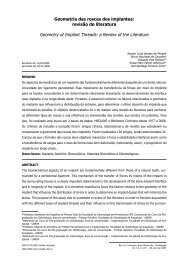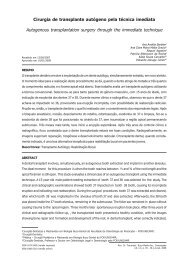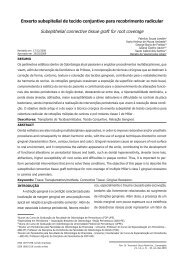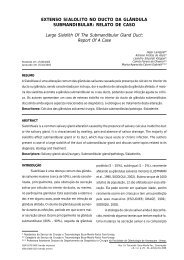Artigo Completo - brazilian journal of oral and maxillofacial surgery
Artigo Completo - brazilian journal of oral and maxillofacial surgery
Artigo Completo - brazilian journal of oral and maxillofacial surgery
Create successful ePaper yourself
Turn your PDF publications into a flip-book with our unique Google optimized e-Paper software.
SANTOS, et al.<br />
laterognatism in the Oral <strong>and</strong> Maxill<strong>of</strong>acial Surgery Unit <strong>of</strong> the Federal University <strong>of</strong> Parana over a period<br />
<strong>of</strong> six years. Data (gender, age <strong>and</strong> dent<strong>of</strong>acial deformity presented) were collected <strong>and</strong> correlated with<br />
the complications by means <strong>of</strong> statistical analysis (Fischer, Mann Whitney <strong>and</strong> Kruskal Wallis tests). Results:<br />
Females were predominant (69.6%). The median age was 23 years (14-65). There were no statistical associations<br />
between gender <strong>and</strong> complications (p=0.269) or between age <strong>and</strong> complications (p=0.071).<br />
Of a total <strong>of</strong> 46 patients, 11 (23.9%) had at least one complication. The most prevalent intraoperative<br />
complications were visible damage to the inferior alveolar nerve (n= 6/13%) <strong>and</strong> inadequate fractures <strong>of</strong><br />
the bone segments (n=6/13%). Inferior alveolar nerve paresthesia was the most frequent postoperative<br />
complication (n=6/13%). There were no statistical associations between complications <strong>and</strong> the dent<strong>of</strong>acial<br />
deformity presented by the patients (p=0.389). Conclusion: 23.9% <strong>of</strong> the patients suffered some type <strong>of</strong><br />
complication. There were no statistical associations between complications <strong>and</strong> the variables analyzed.<br />
Descriptors: Osteotomy; M<strong>and</strong>ible; Oral Surgery; Intraoperative Complications; Postoperative Complications.<br />
78<br />
Introdução<br />
As deformidades dent<strong>of</strong>aciais afetam cerca<br />
de 20% da população em geral, comprometendo<br />
a função e a estética 1 . A combinação de terapia<br />
ortodôntica e a cirurgia ortognática é uma modalidade<br />
de tratamento bem estabelecida para a<br />
correção de deformidades dent<strong>of</strong>aciais moderadas<br />
e graves 2 . A cirurgia ortognática tem como objetivo<br />
primordial corrigir as discrepâncias do esqueleto<br />
facial de modo a facilitar a terapia ortodôntica<br />
da má-oclusão 3 . A osteotomia sagital dos ramos<br />
m<strong>and</strong>ibulares (OSRM) é certamente o procedimento<br />
cirúrgico mais utilizado em cirurgia ortognática 4 .<br />
A técnica cirúrgica da OSRM foi descrita inicialmente<br />
por Trauner e Obwegeser 5 e modificada<br />
posteriormente por DalPont 6 , torn<strong>and</strong>o-se o procedimento<br />
de eleição em cirurgias na m<strong>and</strong>íbula. Sua<br />
versatilidade se deve ao fato de seu design <strong>of</strong>erecer<br />
uma ampla área de contato entre os segmentos<br />
ósseos, o que proporciona melhor cicatrização<br />
óssea e estabilidade, além de permitir a aplicação<br />
de fixação estável de forma precisa e adequada 7 .<br />
Essa técnica permite o avanço e recuo m<strong>and</strong>ibular,<br />
gere<strong>and</strong>o a uma melhora da função mastigatória,<br />
da fonética e da harmonia facial do paciente.<br />
No entanto, como todo procedimento cirúrgico,<br />
as correções m<strong>and</strong>ibulares por meio da terapia<br />
cirúrgica podem <strong>of</strong>erecer alguns riscos, tais como:<br />
hemorragias, fraturas inadequadas, posicionamento<br />
incorreto da cabeça da m<strong>and</strong>íbula, infecção, alteração<br />
neurosensorial, entre outras. Diversos fatores<br />
afetam a frequência e o tipo de complicação,<br />
como a abordagem cirúrgica, o material utilizado<br />
no procedimento, tempo cirúrgico, cuidados pósoperatórios<br />
e habilidade do cirurgião 7,8,9 .<br />
O objetivo deste trabalho é analisar a prevalência<br />
das complicações trans e pós-operatórias<br />
dos pacientes submetidos à osteotomia sagital dos<br />
ramos m<strong>and</strong>ibulares.<br />
Materiais e Métodos<br />
Foi realizado um estudo observacional transversal<br />
por meio da análise retrospectiva de prontuários<br />
de pacientes submetidos à cirurgia ortognática<br />
para avanço, recuo ou correção de laterognatismo<br />
m<strong>and</strong>ibular durante seis anos, de junho de 2002 a<br />
junho de 2008. Todos os pacientes foram operados<br />
no Hospital do Trabalhador, na cidade de Curitiba/<br />
PR, Brasil, pelo Serviço de Cirurgia e Traumatologia<br />
Buco-Maxilo-Faciais II (CTBMF II) da Universidade<br />
Rev. Cir. Traumatol. Buco-Maxilo-Fac., Camaragibe v.12, n.1, p. 77-84, jan./mar. 2012<br />
ISSN 1679-5458 (versão impressa) ISSN 1808-5210 (versão online)

















